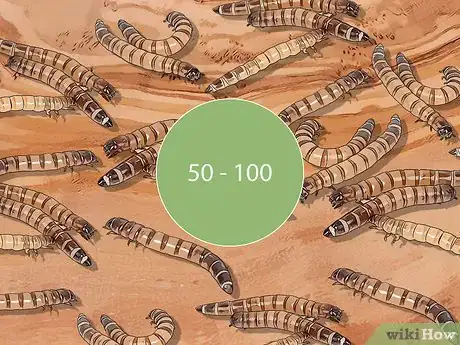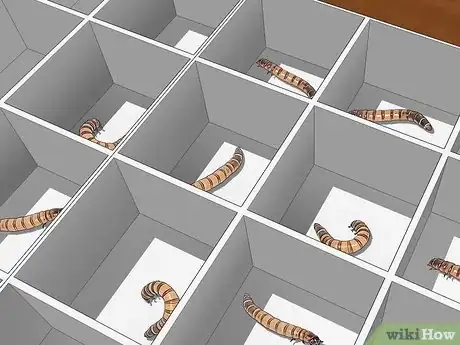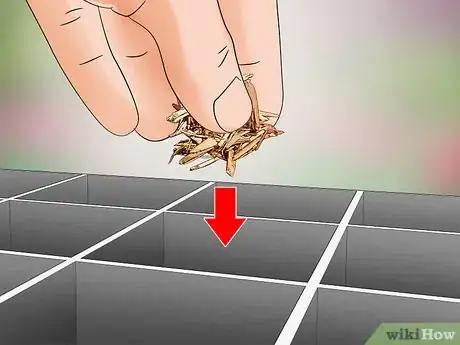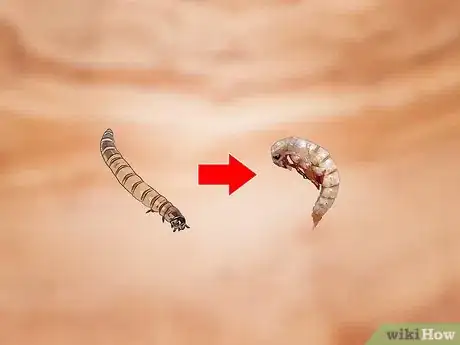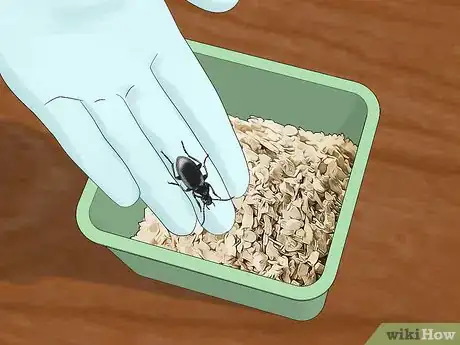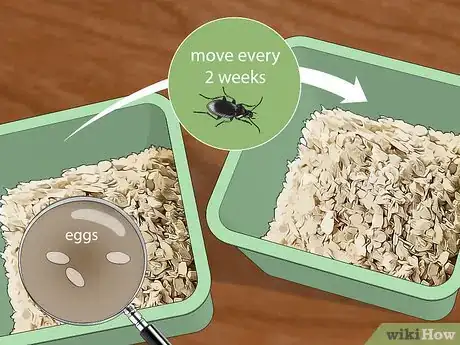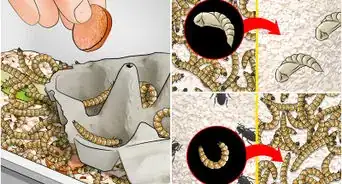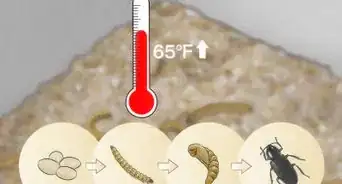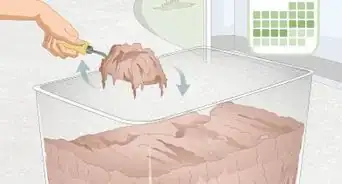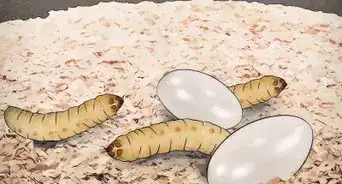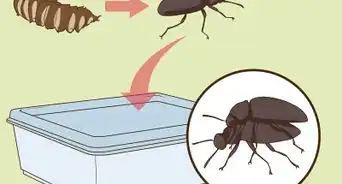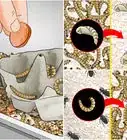This article was co-authored by wikiHow staff writer, Megaera Lorenz, PhD. Megaera Lorenz is an Egyptologist and Writer with over 20 years of experience in public education. In 2017, she graduated with her PhD in Egyptology from The University of Chicago, where she served for several years as a content advisor and program facilitator for the Oriental Institute Museum’s Public Education office. She has also developed and taught Egyptology courses at The University of Chicago and Loyola University Chicago.
wikiHow marks an article as reader-approved once it receives enough positive feedback. In this case, 95% of readers who voted found the article helpful, earning it our reader-approved status.
This article has been viewed 155,324 times.
Learn more...
Superworms are the larvae of darkling beetles. These large worms resemble mealworms and can grow up to 2 inches (51 mm) or longer. They are an excellent source of protein for large reptiles as well as some species of fish and birds (including chickens). Breeding your own superworms is a relatively easy process. Start by isolating some larvae in individual containers to promote pupation. Once the mature beetles emerge, put them together in an appropriate breeding habitat and wait for your baby superworms to arrive.
Steps
Pupating Larval Superworms
-
1Purchase about 50 to 100 superworms. This is a good starting number for beginning your own superworm colony.[1] You can purchase live superworm larvae online or from a pet supply store in your area.
- If you purchase superworms online, check to make sure that the worms you are buying are shipped live.
-
2Place each larva in an individual, ventilated container. You can use plastic film canisters, partitioned craft boxes, condiment cups, or empty plastic cosmetic jars for this purpose.[2] Poke or drill a small hole in the lid of each container so that your superworms can breathe.
- It’s important to store your pupating superworms in their own containers so that adults and other larvae won’t nibble on them while they mature.
- Isolating the superworms in dark containers will also stimulate the pupation process, which could otherwise take up to 5 months to occur naturally.[3]
Advertisement -
3Put a little substrate in each container. Wheat bran or oatmeal will work well for this purpose.[4] Use just enough to cover the bottom of the container. The substrate will serve as both bedding and a source of nourishment for the superworm larvae.
- There’s no need to put any additional food in the containers for the superworm larvae.
- Some breeders recommend against using substrate altogether, since any source of food can slow down the pupating process. If you choose to leave out the substrate, make sure the larvae are already full size (about 2 inches (51 mm) long) before isolating them.[5]
-
4Keep the containers in a warm, dark place for about 10 days. Once the superworms and substrate are in their containers, put the containers in a dark area, such as a drawer or cabinet. Make sure that the storage area is warm, preferably around 80 °F (27 °C).[6]
- It is especially important to keep your superworms in a dark place if you are using transparent or translucent containers, such as glass jars or clear plastic condiment cups.
-
5Check the larvae to see if they have transformed into pupae. Peek in on your superworm larvae occasionally over the next week to 10 days. After a few days, you should notice that most of your superworms have curled up into a “c” or “e” shape. By the end of a week or so, they should begin to transform into “alien”-looking pupae, with a shorter, cream-colored body and ridges that will eventually become legs.[7]
- Any larvae that are stiff and straight or have turned dark in color are probably dead. Discard any dead larvae and replace them with live ones.
-
6Wait about 2 weeks for the pupae to mature. Check the pupae occasionally to look for signs that they are maturing, such as darkening of the legs. It will take about 2 more weeks for the pupae to transform into beetles.[8]
- Continue to store the pupae in separate containers until they mature. If you put the pupae together, the beetles that mature first might snack on the other pupae.
Creating a Habitat for Superworm Beetles
-
1Select a housing container with sides at least 5 inches (13 cm) high. Once your superworms mature into beetles, you will need to offer them a habitat where they can thrive and breed. Look for a container with smooth sides that is ventilated (e.g., with either a screened lid or a solid lid with a mesh-covered air hole) and easy to clean.[9] A few good housing options include:
- A small glass or plastic aquarium or small animal habitat.
- A plastic food storage bin.
- A kitty litter tray.
-
2Put 2 inches (5.1 cm) to 3 inches (7.6 cm) of substrate in the container. Use an edible substrate material such as rolled oats, oat bran, wheat germ, or wheat bran. This material will serve as bedding, a source of food, and a place for your beetles to lay their eggs.[10]
- You may find it difficult to remove your beetles from the bedding if you use a coarse-grained substrate, such as whole oats. You can solve this problem by grinding up the substrate material with a food processor.[11]
-
3Add a piece of fruit or vegetable to the top of the substrate. Offer your superworm beetles a piece of carrot, a slice of potato, or a little bit of fruit. This will provide both food and a source moisture for the beetles. This is critical for preventing your beetles from eating each other and any eggs and larvae in the substrate.[12]
- Change out your fruit or vegetable daily to prevent it from getting moldy.
- If you wish, you can keep the fruit or vegetable pieces off the substrate by placing them on a section of paper egg crate.
- Don’t put a dish of water in the habitat, or it could cause the substrate to become moldy. Your beetles will get enough moisture from the fruit and vegetable pieces.
- You can also lightly mist the substrate with water every other day if you wish. Take care not to let it get too damp, however, or mold could develop.
-
4Keep the habitat at 70 °F (21 °C) to 80 °F (27 °C). House your beetles in a warm environment. Superworm beetles are temperature sensitive, and will die if they become too hot or too cold.[13]
- If necessary, you can use a heat source to warm up your superworm habitat, such as a terrarium heating pad. Monitor the temperature of the habitat carefully to make sure the beetles don’t overheat.
- Never put your superworms or superworm beetles in the refrigerator. Unlike mealworms, the superworms will die if they are exposed to temperatures below 60 °F (16 °C).
Breeding Adult Superworm Beetles
-
1Place the adult beetles in the habitat. Once your pupae mature into adult beetles, you can safely remove them from their individual containers and put them together in the prepared habitat. The adult beetles will breed and lay tiny eggs in the substrate.[14]
- A female superworm beetle can lay up to 500 eggs in her lifetime. Superworm beetles are fertile for their entire adult lives.
- Most adult superworm beetles live about 5 months.
- It may take a few weeks for your beetles to start producing eggs and larvae.
- Check the habitat occasionally for any dead beetles or larvae, and remove them.
-
2Move the beetles to a new container every 2 weeks to protect the larvae. Set up a second habitat with fresh substrate and carefully transfer the adult beetles to their new environment. This will prevent them from eating their eggs and larvae before they have a chance to mature.[15]
- If you have relatively few adult beetles in your habitat, you may be able to wait up to 4 weeks before switching them out.
-
3Allow the baby superworms to mature in the original habitat. Keep the newly hatched larvae in the habitat and continue to feed them pieces of fresh fruit or vegetables until you are ready to feed them to your animals or set them aside for breeding.[16] It may take a few weeks or a few months for the larvae to reach their full size.
- Transfer any larvae you wish to breed into individual breeding containers.
Community Q&A
-
QuestionHow long do superworms live?
 Community AnswerFrom six months to a year, if cared for properly. They also must live with other superworms.
Community AnswerFrom six months to a year, if cared for properly. They also must live with other superworms. -
QuestionWhy are there mini superworms after a few weeks in my superworm cage? Surely those worms don't breed while in the larva stage?
 Community AnswerAre you absolutely sure they are mini superworms? They could be fly larvae. If you are 100% sure, check in the bin for any adult beetles.
Community AnswerAre you absolutely sure they are mini superworms? They could be fly larvae. If you are 100% sure, check in the bin for any adult beetles. -
QuestionCan you mix the small, only weeks old superworms, with the large superworms? Or will the larger ones cannibalize the tiny ones?
 Rosalie MikkelsonCommunity AnswerSometimes they will eat the smaller ones, other times they'll be fine. But you should keep them separated, just for a precaution.
Rosalie MikkelsonCommunity AnswerSometimes they will eat the smaller ones, other times they'll be fine. But you should keep them separated, just for a precaution.
References
- ↑ https://www.herpcenter.com/insect-care-sheets/superworms-care-sheet/
- ↑ http://www.geckotime.com/how-to-breed-superworms/
- ↑ https://entomology.unl.edu/scilit/care/superworms.pdf
- ↑ https://entomology.unl.edu/scilit/care/superworms.pdf
- ↑ http://www.geckotime.com/how-to-breed-superworms/
- ↑ https://entomology.unl.edu/scilit/care/superworms.pdf
- ↑ http://www.geckotime.com/how-to-breed-superworms/
- ↑ http://www.geckotime.com/how-to-breed-superworms/
- ↑ https://entomology.unl.edu/scilit/care/superworms.pdf
- ↑ https://entomology.unl.edu/scilit/care/superworms.pdf
- ↑ http://www.geckotime.com/how-to-breed-superworms/
- ↑ https://entomology.unl.edu/scilit/care/superworms.pdf
- ↑ https://entomology.unl.edu/scilit/care/superworms.pdf
- ↑ http://www.geckotime.com/how-to-breed-superworms/
- ↑ http://www.geckotime.com/how-to-breed-superworms/
- ↑ http://www.geckotime.com/how-to-breed-superworms/
- ↑ https://entomology.unl.edu/scilit/care/superworms.pdf
About This Article
Superworms are the larvae of darkling beetles and are an excellent source of protein for reptiles, fish, and birds. To breed your own, start by buying 50 to 100 superworms and keeping them in individual containers. Put a little substrate, like wheat bran or oatmeal, in each container, and keep them in a warm, dark place for 10 days. After the larvae transform into pupae, wait another 2 weeks for them to mature into beetles. Then, transfer your beetles to a container that’s at least 5 inches tall. Put 2 to 3 inches of substrate down as well as some fruit or vegetable pieces. Every 2 weeks, move your beetles into a new container to keep them from eating their eggs and larvae. To learn how to help baby superworms mature, keep reading!
